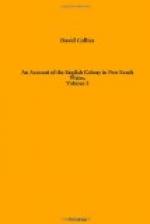The head is rather compressed. The bill, which projects beyond the mouth, in its appearance resembles that of the duck; but is in its structure more like that of the spoonbill, the middle part being composed of bone, as in that bird: it has a very strong cuticular covering.
The nostrils are two orifices, very close to each other, near the end of the bill; the upper lip projecting three quarters of an inch beyond them.
The eyes are very small; they are situated more upon the upper part of the head than is usual, and are directly behind the loose edge of the cuticular flap belonging to the bill. The eyelids are circular orifices concealed in the hair, and, in the male, are with difficulty discovered; but in the female there is a tuft of lighter hair, which marks their situation.
The external ears are two large slits, directly behind the eyes, and much larger than the orifices of the eyelids.
The teeth, if they can be so called, are all grinders; they are four in number, situated in the posterior part of the mouth, one on each side of the upper and under jaw, and have broad flat crowns. They differ from common teeth very materially, having neither enamel nor bone, but being composed of a horny substance only, embedded in the gum, to which they are connected by an irregular surface in the place of fangs. When cut through, which is readily done by a knife, the internal structure is fibrous like the human nail: the direction of the fibres is from the crown downwards.
Between the cheek and the jaw, on each side of the mouth, there is a pouch, as in the monkey tribe, lined with a cuticle. When laid open, it is 11/2 inches long, and the same in breadth. In the female it contained a concreted substance, the size of a very small nut, one in each pouch: this, when examined through the microscope, was found to be made up of very small portions of broken crystals.
Besides these grinding teeth, there are two small pointed horny teeth upon the projecting part of the posterior portion of the tongue, the points of which are directed forwards, seemingly to prevent the food from being pushed into the fauces during the process of mastication; which circumstance Mr. Home thinks peculiar to this animal: in the tongue of the flamingo there is a row of short teeth on each side, but not in any other bird that he has seen.
The fore legs are short, and the feet webbed. On each foot there are five toes, united by the web, which is very broad, and is continued beyond the points of the toes nearly an inch. On each toe there is a rounded straight nail, which lies loose upon the membrane forming the web.
The hind legs are nearly of the same length as the fore legs, but stronger. Each foot has five toes with curved claws, and webbed; but the web does not extend beyond the points of the toes.




